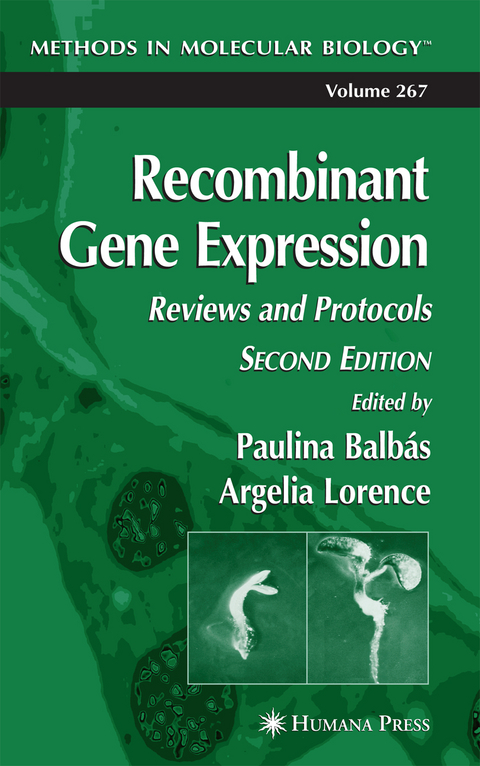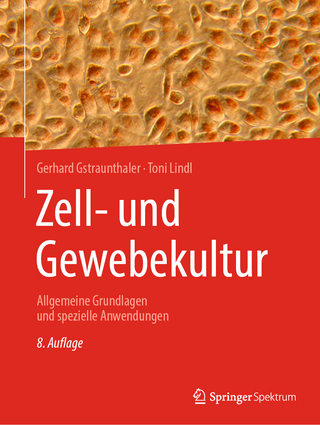
Recombinant Gene Expression
Humana Press Inc. (Verlag)
978-1-61737-460-9 (ISBN)
General Issues About Recombinant Gene Expression.- Host Cell Compatibility in Protein Expression.- Production of Recombinant Proteins.- Folding-Promoting Agents in Recombinant Protein Production.- Prokaryotes.- Back to Basics.- ?-Complementation-Enabled T7 Expression Vectors and Their Use for the Expression of Recombinant Polypeptides for Protein Transduction Experiments.- Expression of Recombinant Alkaline Phosphatase Conjugates in Escherichia coli.- Overexpression of Chromosomal Genes in Escherichia coli.- Chromosomal Expression of Foreign and Native Genes From Regulatable Promoters in Escherichia coli.- Plasmid Vectors for Marker-Free Chromosomal Insertion of Genetic Material in Escherichia coli.- Copy-Control pBAC/oriV Vectors for Genomic Cloning.- Copy-Control Tightly Regulated Expression Vectors Based on pBAC/oriV.- Cell-Free Protein Synthesis With Prokaryotic Combined Transcription-Translation.- Genetic Tools for the Manipulation of Moderately Halophilic Bacteria of the Family Halomonadaceae.- Gene Transfer and Expression of Recombinant Proteins in Moderately Halophilic Bacteria.- Recombinant Protein Production in Antarctic Gram-Negative Bacteria.- Fungi.- Recombinant Protein Production in Yeasts.- Controlled Expression of Homologous Genes by Genomic Promoter Replacement in the Yeast Saccharomyces cerevisiae.- High-Throughput Expression in Microplate Format in Saccharomyces cerevisiae.- High-Throughput Expression in Microplate Format in Pichia pastoris.- Multiple Gene Expression by Chromosomal Integration and CRE-loxP-Mediated Marker Recycling in Saccharomyces cerevisiae.- Three Decades of Fungal Transformation.- Three Decades of Fungal Transformation.- Plants and Plant Cells.- Gene Transfer and Expression in Plants.- Production of Recombinant Proteins by HairyRoots Cultured in Plastic Sleeve Bioreactors.- Engineering the Chloroplast Genome for Hyperexpression of Human Therapeutic Proteins and Vaccine Antigens.- New Selection Marker for Plant Transformation.- Enhancer Detection and Gene Trapping as Tools for Functional Genomics in Plants.- Animals and Animal Cells.- Gene Transfer and Expression in Mammalian Cell Lines and Transgenic Animals.- Sustained Heterologous Transgene Expression in Mammalian and Avian Cell Lines.- Inducible Gene Expression in Mammalian Cells and Mice.- Flp-Mediated Integration of Expression Cassettes into FRT-Tagged Chromosomal Loci in Mammalian Cells.- Generation of High-Recombinant-Protein-Producing Chinese Hamster Ovary (CHO) Cells.- Preparation of Recombinant Proteins in Milk.
| Erscheint lt. Verlag | 10.11.2010 |
|---|---|
| Reihe/Serie | Methods in Molecular Biology ; 267 |
| Zusatzinfo | XVI, 508 p. |
| Verlagsort | Totowa, NJ |
| Sprache | englisch |
| Maße | 152 x 229 mm |
| Themenwelt | Naturwissenschaften ► Biologie ► Mikrobiologie / Immunologie |
| Naturwissenschaften ► Biologie ► Zellbiologie | |
| ISBN-10 | 1-61737-460-1 / 1617374601 |
| ISBN-13 | 978-1-61737-460-9 / 9781617374609 |
| Zustand | Neuware |
| Informationen gemäß Produktsicherheitsverordnung (GPSR) | |
| Haben Sie eine Frage zum Produkt? |
aus dem Bereich


